International S series (bus chassis)
| International S series "Schoolmaster" International 3700/3800 | |
|---|---|
| Overview | |
| Production | 1979–2004 |
| Body and chassis | |
| Class | Class 6 |
| Body style(s) | Cowled chassis (conventional) |
| Related | International S series/International 4000 series (1989–2001) |
| Chronology | |
| Predecessor | International Harvester Loadstar 1703/1803 |
| Successor | International 3300 (DuraStar) |
The bus chassis variant of the International S series is a cowled bus chassis (conventional style) that was produced by International Harvester (later Navistar International) from 1979 to 2004. Produced primarily for school bus applications, the chassis was also produced for other applications, including commercial-use buses and cutaway-cab buses. In addition, the cowled chassis formed the basis for front-engine and rear-engine stripped chassis produced for bus applications.
Designed as a replacement for the International Loadstar bus chassis, the S-series bus chassis was produced in two distinct generations. Matching the development of the International S series, during 1989, the model line underwent a major update, becoming the International 3800. In 2004, the International 3800 ended production, replaced by the International 3300 (a cowled-chassis version of the International 4300/DuraStar). In production for over 25 years, the S-series bus chassis was the longest-lived model line ever produced by International and the final Navistar product line developed by International Harvester.
First generation (S series; 1979–1989)
| International S series "Schoolmaster" | |
|---|---|
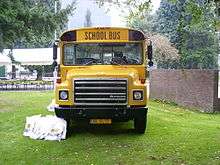 1987-1989 Navistar International S-1800 (retired) | |
 Driver's compartment of a typical 1980s International S-series school bus (Wayne Lifeguard body pictured) | |
| Overview | |
| Manufacturer |
International Harvester Navistar International |
| Also called | International Harvester S-1723/S-1753 "Schoolmaster" |
| Production | 1979–1989 |
| Assembly | Springfield, Ohio |
| Body and chassis | |
| Body style |
|
| Platform | International S series |
| Powertrain | |
| Engine |
Gasoline
Diesel
|
| Transmission |
4-speed manual 5-speed manual Allison AT545 4-speed automatic Allison MT643 4-speed automatic |
| Dimensions | |
| Wheelbase |
|
Released during 1979 production, International Harvester introduced the S-series bus chassis alongside its conventional-cab counterpart. Replacing the bus chassis variant of the International Harvester Loadstar, the S-series chassis continued the use of the "Schoolmaster" product name.[1][2] In a shift from being an adaptation of a truck chassis, the Schoolmaster was designed as a distinct model line intended solely for bus use.[3] Along with completely straight frame rails, the chassis was designed with a flat-back firewall, allowing for body mounting with minimal design adaptations.[1][3]
During its production, the Schoolmaster changed relatively little. Along with revisions to the powertrain, many changes reflected the manufacturer transition from International Harvester to Navistar International. For 1987, the grille underwent a revision, with the "International" wording moved from the top of the grille to the bottom left, paired with a Navistar diamond logo (replacing the IH logo on the steering wheel). In another change, Navistar ended the use of gasoline-fuel engines (in all of its vehicles).
Model overview
The Schoolmaster was produced as a variant of the International S1700 and S1800 (Class 6 trucks), with the lighter-duty S1700 and heavier-duty S1800. Along with powertrain configurations, the two model ranges were distinguished largely by suspension weight capacities.[1][4] Following International traditional model nomenclature, the specific model numbers for the Schoolmasters ended in 3; gasoline-engine examples were given "23" model numbers while diesel-engine examples were given a "53" model number.
| International S-series "Schoolmaster" model designations | |||||
|---|---|---|---|---|---|
| Model Names | S1700 | S1800 | 1853-FC | ||
| S1723 | S1753 | S1823 | S1853 | ||
| Fuel type | Gasoline | Diesel | Gasoline | Diesel | Diesel |
| Years produced | 1979–1986 | c.1983–1989 | 1979–1981 | 1979–1989 | 1981–1989 |
Powertrain
At its launch, the Schoolmaster was offered with four gasoline engines and three diesel engines (dependent on the model range specified). The S1723 was powered solely with gasoline engines, with the International 345 V8 as standard, with three optional gasoline V8s (the 392, and the MV404 and MV446). The S1823 was offered solely with the MV-series V8s (which ended production after 1981). The S1853 was powered by diesel engines, with a standard 9.0L V8, along with a DT466 and Caterpillar 3208 as options (the latter, discontinued around 1982, for the Schoolmaster).
For 1983, an S1753 was introduced to introduce diesel engines to the S1700 chassis; in place of the 9.0L V8 and DT466 inline-6, International debuted a 6.9L IDI-series V8. In 1987, the displacement of the IDI V8 was enlarged to 7.3L. A 4-speed manual was standard on the S1700 variants, while S1800 variants were equipped with a 5-speed manual; a 4-speed automatic was optional on all engines. Following the discontinuation of the MV-series engines, the S-1823 was phased out after 1981, while the S-1723 was phased out after 1986, after International withdrew production of gasoline engines entirely.
| International S series "Schoolmaster" powertrain details[4] | ||||||
|---|---|---|---|---|---|---|
| Engine | Production | Configuration | Fuel | Fuel System | Output | Transmission |
| International Harvester V345 | 1979-1986 | 345 cu in (5.7 l) OHV V8 | Gasoline | Carburetor | 147 hp | 4-speed manual (S-1723 only)
5-speed manual (optional on S-1723, standard on S-1753, S-1823/1853 4-speed automatic (optional all) |
| International Harvester V392 | 392 cu in (6.4 l) OHV V8 | 185 hp | ||||
| International Harvester MV-404 | 1979-1982 | 404 cu in (6.6 l) OHV V8 | 189 hp (2-bbl)
206 hp (4-bbl) | |||
| International Harvester MV-446 | 446 cu in (7.3 l) OHV V8 | 227 hp | ||||
| International Harvester 9.0L V8 | 1980-1989 | 551 cu in (9.0 l) OHV V8 | Diesel | Direct injection | 165 hp
180 hp | |
| International Harvester DT466 | 1979-1989 | 466 cu in (7.6 l) OHV inline-6
turbocharged/naturally aspirated |
180 hp
210 hp | |||
| International Harvester IDI | 1983-1987 (6.9L)
1987-1989 (7.3L) |
420 cu in (6.9 l) OHV V8 | Indirect injection | 155 hp
170 hp | ||
| 444 cu in (7.3 l) OHV V8 | 170 hp
185 hp | |||||
| Caterpillar 3208 | 1979-c.1981 | 636 cu in (10.4 l) OHV V8
turbocharged/naturally aspirated |
Direct injection | 160 hp
175 hp 200 hp 210 hp | ||
Second generation (3800; mid-1989–2004)
| International 3800 | |
|---|---|
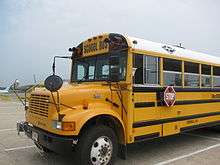 2000–2001 International 3800 (Carpenter Classic 2000 body) | |
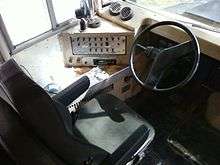 Driver's compartment of a typical 1990s International 3800 school bus | |
| Overview | |
| Manufacturer | Navistar International |
| Also called | International 3700/3800 |
| Production | 1989–2004 |
| Assembly | Springfield, Ohio[5] |
| Body and chassis | |
| Body style |
|
| Platform | International S series |
| Powertrain | |
| Engine | |
| Transmission |
5-speed manual Allison AT545 4-speed automatic Allison MT643 4-speed automatic |
| Chronology | |
| Successor | International 3300 |
In 1989, Navistar redesigned the S-series medium-duty conventionals for the first time since 1979; the medium-duty trucks were renamed the 4000 series. As part of the redesign, the school bus chassis was given a more aerodynamic hood that better integrated the front bumper. On the inside, a two spoke-steering wheel was introduced along with a new instrument cluster. For the first time, the school bus chassis received a separate model designation; the S-1703 was replaced by the 3700; and the S-1803 was replaced by the 3800.
Model history
As with its predecessor, the 3800 would change very little over its 15 years of production. In 1991, the 3600 semi-forward control variant was introduced; this was a chassis designed for the Thomas Vista. After 1994, the lower-GVWR 3700 was discontinued. For 1995, along with all other International medium-duty trucks, the 3800 received chrome hood badges denoting the model series and its engine type; the grille badging changed from red to chrome.
A key event that would affect school bus manufacturing during the later 1990s was the completion of the acquisition of AmTran by Navistar in April 1995. By the end of the decade, AmTran buses would begin to start wearing International badging on the body as well. To promote the change, in 2002, International redesigned the hood for its conventional bus, dubbed the International IC. These wore vertical grille slats instead of horizontal ones seen since 1989 (although the horizontal grille slats continued to be produced for the 3800 until 2004). As it was a change intended to promote IC Corporation, chassis destined for Blue Bird or Canadian manufacturer Corbeil were still received with the standard hood and grille design.
| International S series "Schoolmaster" model designations | ||||||
|---|---|---|---|---|---|---|
| Model names | Conventional | Stripped chassis | ||||
| 3400 | 3600 | 3700 | 3800 | 3900FC | 3000 | |
| Fuel type | Diesel | |||||
| Years produced | 1991–1998 | 1989–1994 | 1989–2004 | 1990–2010 | 1996–present | |
Variants
3400
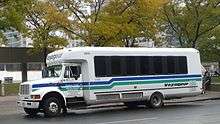
The 3400 was a chassis designed in the same fashion as a Type A cutaway school bus. To achieve a higher GVWR and allow for higher durability, instead of a van, the medium-duty International 4700 was used as a base. While primarily used by builders of transit buses and specialty vehicles, several body manufacturers (Mid Bus and U.S. Bus) would adopt the 3400 for school bus use.
In the school bus industry, Mid Bus and U.S. Bus both developed products based on the 3400, but the chassis became more popular in the transit and specialty vehicle industries instead.
All versions of the 3400 were powered by the 7.3L IDI and T444E V8 engines and used hydraulic brakes. As the 4700 was discontinued after 2001, the 3400 was replaced by the 3200 based upon the new-generation 4000-series trucks (later the DuraStar); currently, the 3200 is used only for transit bus, commercial bus, and specialty vehicle applications.
3600
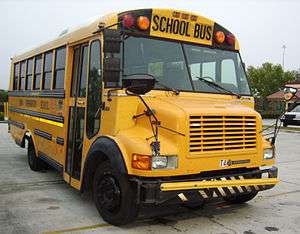
The 3600 was a chassis custom-designed for the Vista from Thomas Built Buses. The Vista combined design elements of a conventional and a forward control school bus. In comparison to a conventional, the driver sat further forward, closer to the front axle. Although much of the engine was located next to the driver like a transit-style bus, access from the front was also maintained via a traditional much-shortened hood. The 3600 chassis was designed in much the same fashion as International's step van chassis, borrowing many components from the 3800.
As it was originally designed specifically for the Vista's body, no other body manufacturers developed their own product lines based on the 3600. It was produced from 1991 until 1998 when Thomas chose to discontinue Vista production after the body manufacturer's purchase by Freightliner.
3700

From 1989 to 1994, International offered two versions of its conventional school bus chassis (as it had with the S series). The 3700 was the lighter-GVWR model of the lineup; only minor differences in powertrain and weight ratings differentiated it from the 3800. The 3700 only was produced with the 7.3 engine.
After 1994, the 3700 was discontinued.
3900
As a replacement for the outdated 1853FC, International introduced the 3900 in 1990 as its forward-control bus chassis. Although primarily used by Ward/AmTran/IC, it has been used by a wide variety of other manufacturers of similar buses. In 2010, International ended production of the 3900.
Powertrain
The 3800 is notable for being the first American school bus chassis to have an engine lineup consisting only of diesel engines. Unlike its S-series predecessor, the 3800 used an all-International lineup of diesel engines.
- Inline-six diesel
- DTA360 (1989–1994)
- DT408 (1994–1995)
- DTA466 (1989–1998)
- DT466 Mechanical Injection
- DT466E Electronic Injection (1996–2005)
- V8 diesel
- Transmission
- Spicer 5-Speed Manual
- Eaton-Fuller 6-Speed Manual
- Spicer 6+1 Manual
- Allison AT545 automatic
- Allison MT643 automatic
- Allison A2000 automatic
Stripped Chassis (1981–present)

Forward control (1981–2010)
Along with the traditional conventional-style cowled chassis, International produced several stripped-chassis variants for transit-style school buses. Using many chassis and powertrain components from the S series, the front-engine 1853FC (FC=Forward Control) was produced from 1981 to 1989. Unlike the conventional, it was powered exclusively by diesel engines. In 1990, the 1853FC was replaced by the more advanced 3900. As with its predecessor, it again shared powertrain and chassis components with its conventional counterpart. In fixing a key drawback of the 1853FC, the 3900 would significantly reduce the interior space needed for the engine, freeing up space for the driver's compartment and front stairwell. The 3900 was produced until 2010.
Rear-engine (1996–present)
In 1996, International introduced its first rear-engine stripped chassis since the early 1970s as the International 3000 became the chassis for the all-new AmTran RE. As with the 3900, the 3000 shared chassis and powertrain components with the 3800. Unlike its front-engine counterpart, the 3000 was designed for the use of both V8 and inline-6 diesel engines. Almost used exclusively used for AmTran and IC school buses, the 3000 remains in production as of 2014.
Body manufacturers
For its production run, the S series was used by many manufacturers of Type C school buses in North America. The same was common practice for the 3800 for the early part of its production run. Following the completion of the 1995 acquisition of AmTran, school bus production began to change as chassis suppliers began to align themselves with body manufacturers. The market share of International actually grew as several body manufacturers such as Wayne and Carpenter would close down and Ford and General Motors were gradually shut out of full-size bus production. By 2004, there were only three body manufacturers of full-size buses (Blue Bird, IC Corporation, and Thomas) and three chassis manufacturers (Blue Bird, Freightliner, and International). Navistar, the parent company of IC Corporation, was the lone chassis manufacturer that sold bus chassis to other body manufacturers.
| International S-series bus chassis usage by school bus manufacturers, 1979–2004 | ||||||
|---|---|---|---|---|---|---|
| Body manufacturer | Chassis variants | Notes | ||||
| Conventional | Front-engine | Rear-engine | ||||
| S1700
S1800 (1979-1989) |
3700
3800 (1989-2004) |
1853FC
(1981-c.1989) |
3900FC
(1989-2010) |
3000
(1996-present) | ||
American Transportation Corporation
(AmTran).jpg) |
AmTran Volunteer (1993-1996) AmTran CS (1997-2002) |
AmTran Genesis (1992-1997) AmTran FE (1998-early 2002) |
AmTran RE (1996-early 2002) | |||
Blue Bird Corporation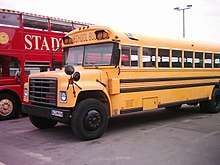 |
Blue Bird Conventional (1979-1989) | Blue Bird Conventional (1989-2004) | Replaced by Blue Bird SBCV (based on International 3300) and Blue Bird Vision. | |||
Carpenter Body Works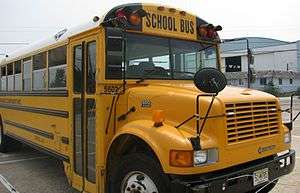 |
Carpenter Classic (1979-1989) | Carpenter (Crown) Classic (1989-1999) Carpenter Classic 2000 (late 1999-2001) |
Carpenter Cavalier (1983-1988) | Carpenter Counselor (1991-1993) | From 1996 to 1999, Carpenter used the Crown by Carpenter brand name on their buses. | |
| Gillig Corporation | Gillig Coach (1979-1981) | The last Gillig Type C bus (Gillig Coach School Bus) was built in 1981; very few were produced. | ||||
Integrated Coach Corporation (IC)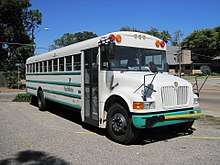 |
International IC (2001) International CE series (late 2001–2004) |
International FE series (2002–2010) | International RE series (2002–present) | The version of the 3800 used by IC wore a modified hood. | ||
| Les Enterprises Michel Corbeil | EMC 1st Premier (c. 1991–1995) Corbeil Conventional (c.1996-c.2004) |
EMC-3900 (c. 1995–2000) | EMC-3900 RE (c.2000–2001) | Corbeil Type C buses were not sold in the United States. | ||
| Mid Bus | The Mid Bus SC is a school bus built on the International 3400 cutaway-cab chassis (with a truck cab and driver-side door); the SC was built during the mid-1990s. | |||||
| New Bus Company | 1988-1989 | |||||
| Superior Coach Company | Superior Pioneer (1979–1985) | Superior ended production of Type C buses in 1985 to concentrate on Type A buses (see Mid Bus) | ||||
| Thomas Built Buses, Inc. |
Saf-T-Liner Conventional (1979-1989) | Saf-T-Liner Conventional (1989-2001) | ||||
| Ward Body Works | Ward Volunteer (1979-1989) | Ward Volunteer (1989-1992) | Ward President (1981-1986) | Ward Senator (1991-1992) | Non-school bus versions of the Volunteer built after 1980 were sold under the AmTran name. | |
| Wayne Corporation |
Wayne Lifeguard (1979-1989) | Wayne Lifeguard (1989-1992) | Wayne Lifestar (1991-1992) | |||
| Wayne Wheeled Vehicles | Wayne Lifeguard (1992-1995) | |||||
See also
- International Harvester – manufacturer (S series)
- Navistar International – manufacturer (3800)
- Chevrolet/GMC B-Series – competing bus chassis
- Ford B-Series – competing bus chassis
- School Bus
- List of buses
References
- 1 2 3 "1981 International Harvester Schoolmaster Chassis 1723 1823 1853 Sales Brochure | eBay". eBay (Product brochure). International Harvester Corporation. Retrieved 2018-05-31.
- ↑ "International Schoolmaster 1723, 1823, 1853". International Harvester Corporation. 1981. p. 1. Retrieved 31 May 2018.
- 1 2 "International Schoolmaster 1723, 1823, 1853". International Harvester Corporation. 1981. pp. 2–4. Retrieved 31 May 2018.
- 1 2 "International Schoolmaster 1723, 1823, 1853". International Harvester Corporation. 1981. p. 8. Retrieved 31 May 2018.
- ↑ https://web.archive.org/web/19970215111950/http://www.navistar.com:80/bus/bus.html
External links

